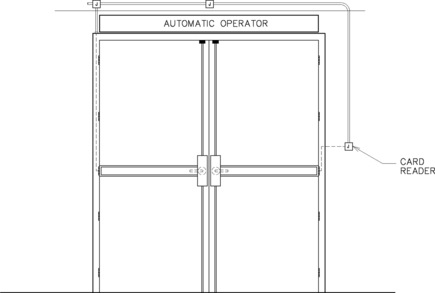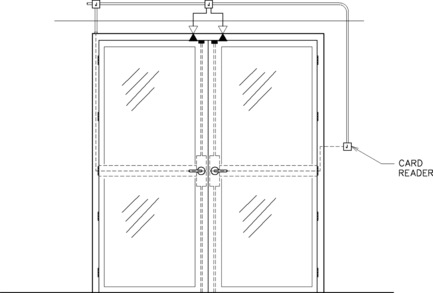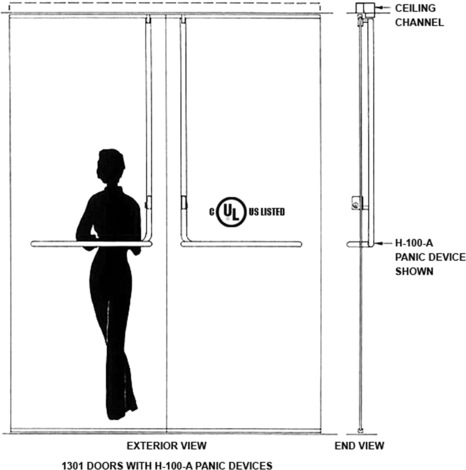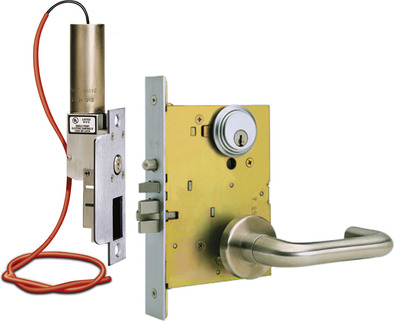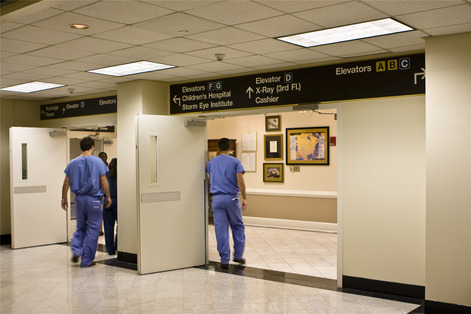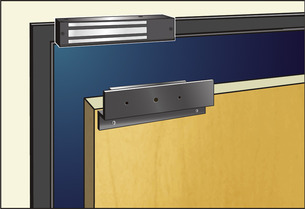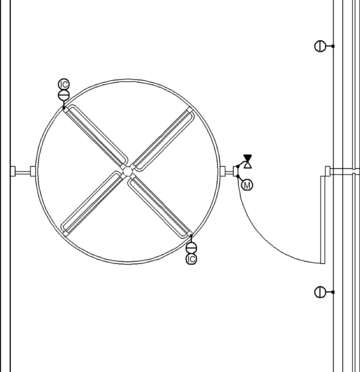14. Selecting the Right Lockset for a Door
Chapter objectives
1. Learn the Basics in the Chapter Overview
2. Get to know Standard Application Rules
3. Look at Several Sample Examples of how to Select locks for Various kinds of doors
4. Answer Questions about Standard Door/Lock Combinations
CHAPTER OVERVIEW
I get questions regularly from consultants, integrators, architects, installers, and repair technicians about which hardware is appropriate for different kinds of doors. Accordingly, for this book I have developed a number of lists that identify proper combinations of doors and locks for different applications.
The lists will include information on Hollow Metal, Solid Core, Framed Glass, Frameless Glass, and Specialty Doors. Variations will include fire-rated doors and normally handed and reverse handed doors for each type of lock with notes on preference.
I get questions regularly from consultants, integrators, architects, installers, and repair technicians about which hardware is appropriate for different kinds of doors. Accordingly, for this book I have developed a number of lists that identify proper combinations of doors and locks for different applications.
These lists will include information on Hollow Metal, Solid Core, Framed Glass, Frameless Glass, and Specialty Doors. Variations will include fire-rated doors, and normally handed and reverse handed doors, for each type of lock with notes on preference.
Keywords: Consultant, Fire, Framed Glass, Frameless Glass, Hollow Metal, Installer, Integrator, Solid Core, Specialty, Technician
Author Information:
Thomas L. Norman, CPP, PSP, CSC, Executive Vice President, Protection Partners International
Standard Application Rules
Here are the priorities I suggest:
1. As always, life safety first.
2. For Fire Doors on Corridors and Occupancies 50 and over — Electrified Panic Hardware
3. For Fire Doors off Corridors and Occupancies less than 50 — Electrified Mortise Locks
4. For Non-Fire Doors
• Electrified Mortise Locks
• Magnetic Locks with safety provisions
These priorities will be adjusted by door type in the list below.
How to Select the Right Lock for Any Door
The variables to consider when choosing door locking hardware include:
• Is the door fire rated?
• What kind of door is it?
• What is the level of traffic through the door?
• Is the door standard or reversed swing? (A standard door opens toward you from the outside while a reverse swing door opens toward you from the inside.)
Let's try an exercise to see how this works. First we will describe a door and begin with all of the possible types of locks available, eliminating some each time we describe an attribute of the door. This will leave us with a short-list of possible locks to use on the door.
Description of Door
This is a pair of double doors leading to an Information Technology Server Room, off a Fire Corridor. The room has occupancy of less than 50. Frequently, heavy carts are moved into and out of the room by two or more people. Accordingly, the door is opened by an automatic operator. The room is equipped with an FM-200 Fire Suppression System, so quick egress is required. The doors are recessed into a pocket so that the doors can swing out toward the hallway without extending into the hallway.
First, let's begin with the entire list of possible locks including those that we will not use:
• Electrified Panic Hardware
• Rim
• Mortise
• Vertical Rods
• Electrified Mortise Lock
• Electrified Cylinder Lock
• Electric Strike
• Magnetic Locks
• 3-point Locking Mechanism
• Securitech Locks
• Hi-Tower™ Lock
• Blumcraft™ Lock
Now, let's analyze the selection process, step by step:
A. The doors are fire-rated doors, so no Electrified Strike and better not to use Magnetic Locks.
• Electrified Panic Hardware
- Rim
- Mortise
- Vertical Rods
• Electrified Mortise Lock
• Electrified Cylinder Lock
• Electric Strike
• Magnetic Locks
• 3-point Locking Mechanism
• Securitech Locks
• Hi-Tower Lock
• Blumcraft Lock
B. The doors are hollow metal, so no Blumcraft Lock.
• Electrified Panic Hardware
- Rim
- Mortise
- Vertical Rods
• Electrified Mortise Lock
• Electrified Cylinder Lock
• Electric Strike
• Magnetic Locks
• 3-point Locking Mechanism
• Securitech Locks
• Hi-Tower Lock
• Blumcraft Lock
C. The doors are automatically operated so any lock requiring coordination of the two door leaves is out (Electrified Mortise Lock, Electrified Cylinder Lock, 3-point Locking Mechanism, Securitech Locks, and Hi-Tower Lock).
• Electrified Panic Hardware
- Rim
- Mortise
- Vertical Rods
• Electrified Mortise Lock
• Electrified Cylinder Lock
• Electric Strike
• Magnetic Locks
• 3-point Locking Mechanism
• Securitech Locks
• Hi-Tower Lock
• Blumcraft Lock
D. This leaves Electrified Panic Hardware, so let's finalize the selection. The door is automatically operated so no Rim or Mortise version.
• Electrified Panic Hardware
- Rim
- Mortise
- Vertical Rods
• Electrified Mortise Lock
• Electrified Cylinder Lock
• Electric Strike
• Magnetic Locks
• 3-point Locking Mechanism
• Securitech Locks
• Hi-Tower Lock
• Blumcraft Lock
E. The selection is Electrified Panic Hardware with Vertical Rods (EPH-VR; Figure 14.1) that are interfaced to the Automatic Operator to unlock the Vertical Rods before actuating the Automatic Operator and then re-engaging after the doors are closed again by the operator.
Let's try a few more examples.
Framed Glass Door
This time let's look at a set of framed glass doors that leads from a company cafeteria to an outdoor employee patio (Figure 14.2). The doors are unlocked from the outside by a card reader. These doors are from an area with occupancy of 200, so they are classed as fire exit doors.
A. This is a set of Framed Glass Doors, so no Blumcraft Hardware.
• Electrified Panic Hardware
- Rim
- Mortise
- Vertical Rods
• Electrified Mortise Lock
• Electrified Cylinder Lock
• Electric Strike
• Magnetic Locks
• 3-point Locking Mechanism
• Securitech Locks
• Hi-Tower Lock
• Blumcraft Lock
B. Double doors must operate independently, so no coordinator is allowed.
• Electrified Panic Hardware
- Rim
- Mortise
- Vertical Rods
• Electrified Mortise Lock
• Electrified Cylinder Lock
• Electric Strike
• Magnetic Locks
• 3-point Locking Mechanism
• Securitech Locks
• Hi-Tower Lock
• Blumcraft Lock
C. These are fire exit doors, so it is best not to use Magnetic Locks.
• Electrified Panic Hardware
- Rim
- Mortise
- Vertical Rods
• Electrified Mortise Lock
• Electrified Cylinder Lock
• Electric Strike
• Magnetic Locks
• 3-point Locking Mechanism
• Securitech Locks
• Hi-Tower Lock
• Blumcraft Lock
D. The choice again is EPH-VR.
Herculite™ Lobby Doors
These are 10-foot tall unframed glass doors in the Main Lobby of a Class A Office Building. The Owner wants to make a good impression on everyone entering the lobby, but he wants to lock the doors after hours, allowing only those who have an access card to enter.
A. First let's eliminate all locks that do not work with Frameless Glass Doors.
• Electrified Panic Hardware
- Rim
- Mortise
- Vertical Rods
• Electrified Mortise Lock
• Electrified Cylinder Lock
• Electric Strike
• Magnetic Locks
• 3-point Locking Mechanism
• Securitech Locks
• Hi-Tower Lock
• Blumcraft Lock
B. This leaves Magnetic Locks, EPH-VR, and Blumcraft Locks. Since the Owner wants the doors to make the best impression, we will select the Blumcraft Electrified Door Hardware (Figure 14.3).
High-Rise Building Stair-Tower Door
Next, let's look at a stair-tower door in a high-rise building (Figure 14.4). The stair-tower is pressurized and the door is hollow metal. The door will be electrically locked to permit re-entry only to authorized personnel. The door leads from occupancy of less than 50.
A. This is a hollow metal door so let's eliminate all locks that work only on glass doors.
• Electrified Panic Hardware
- Rim
- Mortise
- Vertical Rods
• Electrified Mortise Lock
• Electrified Cylinder Lock
• Electric Strike
• Magnetic Locks
• 3-point Locking Mechanism
• Securitech Locks
• Hi-Tower Lock
• Blumcraft Lock
B. There is a stair-tower door so it must latch on closure.
• Electrified Panic Hardware
- Rim (can be dogged, so not acceptable)
- Mortise
- Vertical Rods (can be dogged, so not acceptable)
• Electrified Mortise Lock
• Electrified Cylinder Lock
• Electric Strike
• Magnetic Locks
• 3-point Locking Mechanism
• Securitech Locks
• Hi-Tower Lock
• Blumcraft Lock
C. Must be a robust electrified lock.
• Electrified Panic Hardware
- Rim
- Mortise
- Vertical Rods
• Electrified Mortise Lock
• Electrified Cylinder Lock
• Electric Strike
• Magnetic Locks
• 3-point Locking Mechanism
• Securitech Locks
• Hi-Tower Lock
• Blumcraft Lock
D. No dead-bolt is allowed.
• Electrified Panic Hardware
- Rim
- Mortise
• Electrified Mortise Lock
• Electrified Cylinder Lock
• Electric Strike
• Magnetic Locks
• 3-point Locking Mechanism
• Securitech Locks
• Hi-Tower Lock
• Blumcraft Lock
E. This leaves us with the three choices as listed above. Perhaps we will select the Hi-Tower Lock as it requires the least door modification.
Rear-Exit Door on Warehouse with Hi-Value Equipment
Now, let's take a look at a single, rear-exit door on a warehouse. This is a hollow metal door and the warehouse has been broken into a couple of times through weak door hardware. We are looking for something very robust. The door is a fire egress door.
A. Hollow Metal Door, so let's rule out all locks that will not work with these.
• Electrified Panic Hardware
- Rim
- Mortise
- Vertical Rods
• Electrified Mortise Lock
• Electrified Cylinder Lock
• Electric Strike
• Magnetic Locks
• 3-point Locking Mechanism
• Securitech Locks
• Hi-Tower Lock
• Blumcraft Lock
B. The door is a fire egress door, so let's rule out all locks that should not be used with these.
• Electrified Panic Hardware
- Rim
- Mortise
- Vertical Rods
• Electrified Mortise Lock
• Electrified Cylinder Lock
• Electric Strike
• Magnetic Locks
• 3-point Locking Mechanism
• Securitech Locks
• Hi-Tower Lock
• Blumcraft Lock
C. We need a very robust lock that can foil even the best attempts at entry.
• Electrified Panic Hardware
- Rim
- Mortise
- Vertical Rods
• Electrified Mortise Lock
• Electrified Cylinder Lock
• Electric Strike
• Magnetic Locks
• 3-point Locking Mechanism
• Securitech Locks
• Hi-Tower Lock
• Blumcraft Lock
D. This leaves us with the two choices listed above. The best choice would be Panic Hardware equipped Electrified Dead-Bolts. Let them try to get past those locks!
Office Suite Door
In this selection, we have a 12 foot solid core wood door that leads to/from an office suite with occupancy of less than 50. The Owner wants to maintain the original look of the door. The door swings out of the suite into the corridor.
A. First, let's remove all locks that would not work with solid core doors.
• Electrified Panic Hardware
- Rim
- Mortise
- Vertical Rods
• Electrified Mortise Lock
• Electrified Cylinder Lock
• Electric Strike
• Magnetic Locks
• 3-point Locking Mechanism
• Securitech Locks
• Hi-Tower Lock
• Blumcraft Lock
B. Now let's remove all locks that would not maintain the elegant look of the finely finished solid core wood door.
• Electrified Panic Hardware
- Rim
- Mortise
- Vertical Rods
• Electrified Mortise Lock
• Electrified Cylinder Lock
• Electric Strike
• Magnetic Locks
• 3-point Locking Mechanism
• Securitech Locks
• Hi-Tower Lock
• Blumcraft Lock
C. We need good security on this suite, so let's remove the weak locks.
• Electrified Panic Hardware
- Rim
- Mortise
- Vertical Rods
• Electrified Mortise Lock
• Electrified Cylinder Lock
• Electric Strike
• Magnetic Locks
• 3-point Locking Mechanism
• Securitech Locks
• Hi-Tower Lock
• Blumcraft Lock
D. Finally, this is an existing door on an occupied office suite, so the Owner cannot remove the door to be cored for an Electrified Mortise Lock, so the final selection is a Hi-Tower Lock, which does not require coring the door.
Double-Egress Doors — Hospital Corridor
In hospitals, it is common to see Double-Egress Doors that allow the passage of a gurney or cart in both directions. The doors will not have a center mullion, so there will be a clear expanse of space when both doors are open. These doors will get a lot of abuse as carts go through them, and each will be operated by its own Automatic Door Operator. This is a new hospital.
A. This is new construction, so we can add Total Doors® as an option.
• Electrified Panic Hardware
- Rim
- Mortise
- Vertical Rods
• Electrified Mortise Lock
• Electrified Cylinder Lock
• Electric Strike
• Magnetic Locks
• 3-point Locking Mechanism
• Securitech Locks
• Hi-Tower Lock
• Blumcraft Lock
• Total Doors
B. We need doors that will work with no mullions.
• Electrified Panic Hardware
- Rim
- Mortise
- Vertical Rods
• Electrified Mortise Lock
• Electrified Cylinder Lock
• Electric Strike
• Magnetic Locks
• 3-point Locking Mechanism
• Securitech Locks
• Hi-Tower Lock
• Blumcraft Lock
• Total Doors
C. The doors are in a fire corridor, so let's eliminate locks that should not be used in this environment.
• Electrified Panic Hardware
- Rim
- Mortise
- Vertical Rods
• Electrified Mortise Lock
• Electrified Cylinder Lock
• Electric Strike
• Magnetic Locks
• 3-point Locking Mechanism
• Securitech Locks
• Hi-Tower Lock
• Blumcraft Lock
• Total Doors
D. Since the doors will be in a very high abuse environment, let's use Total Doors, which are especially well suited to this need (Figure 14.5).
Inswinging Office Door
This is a simple application. The office includes storage of important files and has occupancy of six workers. The door is a solid core wood door in a middle-management environment. It is an existing door in an aluminum frame, so frame strength is an issue. The door is existing, in use, and is currently equipped with a mechanical cylinder lock.
A. Let's eliminate all locks that are not appropriate to this type of door (inswinging solid core wood door).
• Electrified Panic Hardware
- Rim
- Mortise
- Vertical Rods
• Electrified Mortise Lock
• Electrified Cylinder Lock
• Electric Strike
• Magnetic Locks
• 3-point Locking Mechanism
• Securitech Locks
• Hi-Tower Lock
• Blumcraft Lock
B. Let's consider that the frame is weak so let's not modify the frame if possible.
• Electrified Panic Hardware
- Rim
- Mortise
- Vertical Rods
• Electrified Mortise Lock
• Electrified Cylinder Lock
• Electric Strike
• Magnetic Locks
• 3-point Locking Mechanism
• Securitech Locks
• Hi-Tower Lock
• Blumcraft Lock
C. We want a strong lock as the information assets in this room are significant, so let's eliminate the electrified cylinder lock.
• Electrified Panic Hardware
- Rim
- Mortise
- Vertical Rods
• Electrified Mortise Lock
• Electrified Cylinder Lock
• Electric Strike
• Magnetic Locks
• 3-point Locking Mechanism
• Securitech Locks
• Hi-Tower Lock
• Blumcraft Lock
D. We don't have time to ship the door out to be modified to accommodate an Electrified Mortise Lock, so we will select a Magnetic Lock with an Infrared Request-to-Exit Sensor and a Pneumatic Exit Switch (Figure 14.6).
Revolving Door — Emergency Egress Side Door
This is a Revolving Door on a 4th floor Corridor that leads directly from an Elevator Lobby to an adjacent Parking Structure. We need to ensure that visitors do not enter at this level and we want to ensure that we account for every person who comes and goes into the adjacent Trading Room. A Revolving Door has been recommended to deal with the accounting of people coming and going, but in this circumstance, fire code requires an adjacent exit door. The adjacent door is a framed glass door. The Owner wants the adjacent door locked at all times, which is not allowed under fire code.
A. First let's look at which locks we have used in previous lists that fit both the fire code and the Owner's wishes.
• Electrified Panic Hardware
- Rim
- Mortise
- Vertical Rods
• Electrified Mortise Lock
• Electrified Cylinder Lock
• Electric Strike
• Magnetic Locks
• 3-point Locking Mechanism
• Securitech Locks
• Hi-Tower Lock
• Blumcraft Lock
B. Oops! We can't use any of these. But if we look at fire code, we find that a Delayed Egress Lock is permitted. It complies with fire code and allows the door to remain locked at all times except in an emergency. The delayed egress hardware must be equipped with an interface to the fire alarm system (Figure 14.7).
Chapter Summary
1. For standard application rules in selecting locks, here are the priorities I suggest:
• As always, Life Safety first.
• For Fire Doors on Corridors and Occupancies 50 and over — Electrified Panic Hardware
• For Fire Doors off Corridors and Occupancies less than 50 — Electrified Mortise Locks
• For Non-fire Doors
- Electrified Mortise Locks
- Magnetic Locks with safety provisions
2. When selecting locks, the variables to consider when choosing door-locking hardware include:
• Is the door fire rated?
• What kind of door is it?
• What is the level of traffic through the door?
• Is the door standard or reversed swing? (A standard door opens toward you from the outside while a reverse swing door opens toward you from the inside.)
1) What is the first consideration for selecting the right lockset for a door?
a. For Fire Doors off corridors and occupancies less than 50 — Electrified Mortise Locks
b. For Fire Doors on corridors and occupancies 50 and over — Electrified Mortise Locks
c. For Non-fire Doors: Electrified Mortise Locks and Magnetic Locks with safety provisions
d. Life Safety first
2) Which of the following are criteria you should consider when selecting the right lock for a door?
a. Is the door Fire Rated?
b. What kind of door is it?
c. Both a and b
d. Neither a nor b
3) Which of the following are criteria you should consider when selecting the right lock for a door?
a. What is the level of traffic through the door?
b. Is the door standard or reversed swing?
c. Both a and b
d. Neither a nor b
4) A standard door swing
a. Opens away from you
b. Opens toward you
c. Swings to and fro
d. Swings on hinges
5) A reversed door swing
a. Opens away from you
b. Opens toward you
c. Swings to and fro
d. Swings on hinges
6) What kind of lock is best for a pair of double doors leading to an Information Technology Server Room, off a Fire Corridor?
a. Electrified Mortise Lock
b. Blumcraft Hardware
c. Hi-Tower Lock
d. Electrified Panic Hardware with Vertical Rods
7) What kind of lock is best for a set of framed glass doors that leads from a company cafeteria to an outdoor employee patio?
a. Electrified Mortise Lock
b. Blumcraft Hardware
c. Hi-Tower Lock
d. Electrified Panic Hardware with Vertical Rods
8) What kind of lock is best to use on 10-foot tall unframed glass doors in the main lobby of a Class A office building?
a. Electrified Mortise Lock
b. Blumcraft Hardware
c. Hi-Tower Lock
d. Electrified Panic Hardware with Vertical Rods
9) What kind of lock is best to use on an existing hollow metal door in a pressurized stair tower within a high-rise building?
a. Electrified Mortise Lock
b. Blumcraft Hardware
c. Hi-Tower Lock
d. Electrified Panic Hardware with Vertical Rods
10) What kind of lock is best to use on a single, rear-exit door on a high-value warehouse that has been broken into several times in the past. The door is a fire egress door.
a. Magnetic Lock
b. Panic Hardware equipped Multipoint Dead-Bolt Securitech Lock
c. Electric Strike
d. Electrified Mortise Lock
11) What kind of lock is best to use on a 12-foot solid core wood door that leads to/from an occupied office suite with an occupancy of less than 50, where the owner wants a robust lock and to maintain the original look of the door and the owner does not want to core the doors?
a. Magnetic Lock
b. Hi-Tower Lock
c. Electrified Mortise Lock
d. Electric Strike
12) What kind of lock is best to use on Double-Egress Hospital Doors with no center mullion?
a. Electrified Panic Hardware with Vertical Rods
b. Electrified Panic Hardware with Horizontal Rods
c. Electrified Panic Hardware with Rim Hardware
d. Total Doors
13) What kind of lock is best to use on a solid-core inswinging office door with an aluminum frame and occupancy of six workers where the lock is protecting important assets and the lock must be installed immediately?
a. Electric Strike
b. Electrified Mortise Lock
c. Hi-Tower Lock
d. Magnetic Lock
14) What kind of lock should be placed on a single-leaf fire egress door located right next to a revolving door, where we wish to guide people through the revolving door except in an emergency?
a. Securitech Lock
b. Blumcraft Lock
c. Delayed Egress Lock
d. No lock is legal on this door
Answers: 1) d, 2) c, 3) c, 4) b, 5) a, 6) d, 7) d, 8) b, 9) c, 10) b, 11) b, 12) d, 13) d, 14) c
..................Content has been hidden....................
You can't read the all page of ebook, please click here login for view all page.

